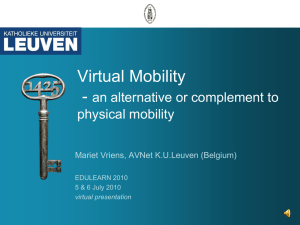Wheelchairs - Whizz-Kidz
advertisement
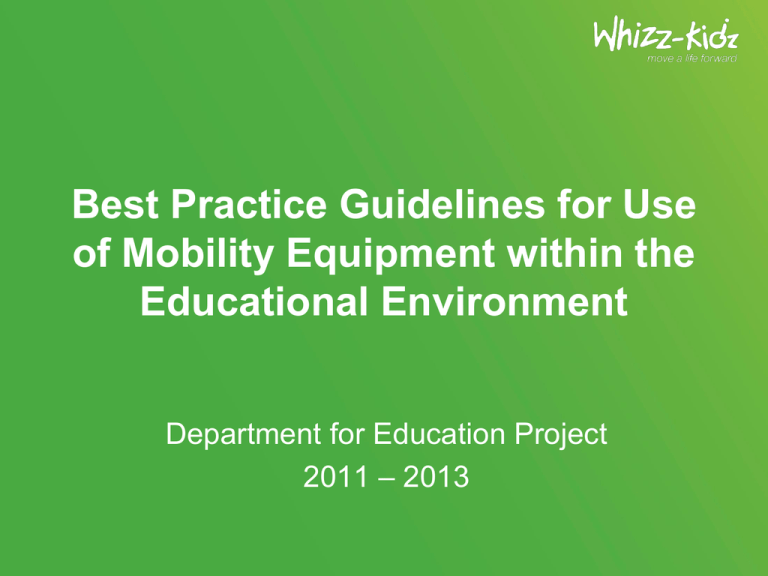
Best Practice Guidelines for Use of Mobility Equipment within the Educational Environment Department for Education Project 2011 – 2013 Outline of Presentation • Introduction • Advantages of Independent Mobility • Educational Outcomes of Independent Mobility • Wheelchair Skills Training • Risk Assessment • Wheelchair Provision during Transitional Stages • Guidance on Use of Transport Services Introduction to Whizz-Kidz • • • • • Medium sized national charity Independence to enjoy an active childhood Life Journey approach Highly qualified mobility therapists Partnership working within the NHS What we do We give disabled children and young people across the UK customised mobility equipment, training, advice and life skills. But more than this, we give them the independence to be themselves. We make an immediate and life changing difference to them, their families and their communities. Introduction Number of disabled children using assistive technology has increased by 60% (Long et al 2003) “…the window that enables a child to have greater independence and more active involvement in play.” (Judge 2002) Advantages of Independent Mobility • A child is expected to learn more about their world through movement • Benefits increase interactions with people, objects and surrounding environments • Aids the development of cognitive, emotional and psychological skills • Interactions create sense of achievement and autonomy leading onto further exploration Lack of independence may mean: •decreased motivation •reduced confidence •feelings of frustration •passive •incurious •learned helplessness Nisbet 2002 Advantages of Independent Mobility Research shows that children should be provided with equipment to enable them to become independent as close as possible to the age when mobility would be occurring naturally within normal childhood development Butler 1986 Educational Outcomes of Independent Mobility • Current inclusive education polices and integrated therapy approaches • Inclusive education means more prominent existence of wheelchairs in educational milieu • “…the culture and curriculum of a school has the flexibility to include children whatever the nature or extent of their special educational needs.” (Mackey & McQueen 1998) • “Through the use of AT devices many students can decrease their isolation and become an important part of a regular classroom; their least restrictive environment.” (Cavanaugh 2002) Educational Outcomes of Independent Mobility Educational outcomes: • Specified National Curriculum standards • Attainment of formal qualifications • Friendships that will be made • Acceptable social behaviours that will be shaped Section 351 of Education Act 1996: 1) Promotes the spiritual, moral, cultural, mental and physical development of pupils at the school and of society. 2) Prepares pupils at the school for the opportunities, responsibilities and experiences of adult life. Educational Outcomes of Independent Mobility The Child / Young Person • Provision of right equipment at the right time • Active responsibility for their learning • Taking some responsibility for the equipment prescribed • Provided equipment will enable meeting of educational outcomes Educational Outcomes of Independent Mobility The Teachers / School • Use of staff when training a child in using their wheelchair • Staff are then able to reinforce skills and ensure equipment aids the personal and educational outcomes • Close communication and involvement within all wheelchair service processes Educational Outcomes of Independent Mobility Whizz-Kidz aims to: 1. Involve school staff and therapists as much as possible within their processes 2. Carry out assessment and fitting clinics held within school environments 3. Provide advice and training to schools regarding posture, seating and general use of powered and manual wheelchairs 4. Organise Wheelchair Skills Training courses within school environments Wheelchair Skills Training • Providing disabled children with wheelchairs means making sure they know how to use them to their full potential • Improving confidence and independence in the process • Achieving individual potential through a codified programme of wheelchair skills training • Schemes of work for complex needs, beginners and advanced users Wheelchair Skills Training Whizz-Kidz delivers approximately 72 courses to 750 children and young people 40 schemes will be held within the school environment Involvement of school staff promotes a ‘carry-over’ effect of skills taught Wheelchair Skills Training Wheelchair trainer coordinators are wheelchair users themselves, which raises aspirations of the participants and provides them with valuable role models. Running these courses in schools increases staff confidence and gives them the chance to see the equipment in use. Risk Assessments relating to Wheelchair Provision A risk assessment is: “…a careful examination of what, in your work, could cause harm to people, so that you can weigh up whether you have taken enough precautions or should do more to prevent harm.” Health and Safety Executive 2011 Three main risk areas associated with wheelchairs: 1) School environment 2) Use of harnesses and belts 3) Manual handling Risk Assessment School environment Key components to consider: • Access to buildings and play areas • Steps • Steepness of ramps • Doorways • Corridors • Turning space • Toileting and changing facilities • Storage and charging Risk Assessment Use of harnesses and belts Guidance on the Use of Restrictive Physical Interventions “ Devices which are required for therapeutic purpose, such as buggies, wheelchairs and standing frames (including any supporting harness) may also restrict movement. Such devices should never be provided for the purpose of preventing problem behaviour, although, in extreme circumstances, they might be used to manage risks.” DOH 2002 Risk Assessment Use of harnesses and belts Managing problem behaviour must be: • Risk assessed with MDT, user, parents / guardians • Documented in care plan • Identify risks to staff and risks of not intervening • Wheelchair providers policy will probably state for ‘postural use only’ but will not be in a position to monitor Risk Assessment Manual Handling • Legislation indicates best practice for pushing / pulling of wheelchairs • Size and type prescribed based on user’s needs • Consideration given to change of environment • Implications on postural and pressure management equipment when slings left in situ Wheelchair provision during transitional stages • Transition between primary and secondary school is a difficult time. • Increased anxieties for child, increased expectations for parents. • Children often fall behind in their learning, which increases stress and trepidation. • DfES Five Year Strategy for Children and Learners (2004) Wheelchair provision during transitional stages Whizz-Kidz endeavours to pre-empt key transitional stages within a child and young person’s life, so that the right mobility equipment is provided at the right time. Primary School- to move from a buggy to a wheelchair • • • • Independence Interaction with peers Element of growth in equipment Low seat to ground height Wheelchair provision during transitional stages Secondary School – to move towards powered mobility • Proceeding 12 months • Powered mobility for less efficient selfpropellers • Increase independence • Conserve energy • Risers for accessing alternative school environment Wheelchair provision during transitional stages Adulthood – further education, employment, socialising • Additional features onto powered wheelchairs i.e. lights, indicators, increased speeds • Promote independence • Improve social, educational and employment interactions Whizz-Kidz support during transitional stages Ambassador Clubs Kidz Unlimited Whizz-Kidz support during transitional stages Skillz for Life Camp Whizz-Kidz Work Experience Placements Guidance on the use of transport services Medical Devices Agency (MDA) 2001 states: • 750,000 wheelchair users within the UK – very few problems or incidents occurring • Minimum standards which are advocated for a user who travels in their equipment in a vehicle • Individual manufacturers’ guidelines and standards set by International Standards Organisation (ISO) Guidance on the Safe Transportation of Wheelchairs (MDA 2001) Guidance on the use of transport services ISO 7176-19:2008 Wheeled mobility devices for use as seats in motor vehicles Crash test: full frontal collision, 48 km/h, deceleration of 20g with a 75kg test dummy. Minimum standards = suitable for use in transport ISO 10542 1-5:2001 Wheelchair Tie-Down and Occupant Restraint Systems (WTORS) Crash test: full frontal collision, 48 km/h, deceleration of 20g with a 75kg test dummy and 85kg surrogate wheelchair Minimum standards = suitable for use in transport, however, some systems have been tested exceeding minimum standards Guidance on the use of transport services According to the MDA 2001: “… in the small number of injuries and fatalities recorded, investigations reveal that the cause is rarely attributed to a piece of faulty equipment. The majority are the result of inappropriate, inadequate or incorrectly used equipment.” Main problems include: 1) Lack of consistent communication 2) Lack of product information 3) Inadequate training 4) Inappropriate use of WTORS 5) Not securing unoccupied wheelchairs 6) Incorrect use of tail lifts / ramps Guidance on the use of transport services • Holistic assessment considers the use of equipment in family or school transport. • Advises transferring out of equipment where possible. • Does not advocate compromising on prescription for transportation needs. • Encourages communication between schools, wheelchair service provider and community transport. References Butler C (1986) Effects of Powered Mobility on Self-Initiated Behaviours of Very Young Children with Locomotor Disability Developmental Medicine & Child Neurology Vol 28: 325-332 Cavanaugh T (2002) The Need for Assistive Technology in Educational Technology Educational Technology Review Vol 10(1) Department for Education and Skills (2004) Five Year Strategy for Children and Learners: putting people at the heart of public services London: HM Government Department of Health (2002) Guidance for restrictive physical interventions: How to provide safe services for people with learning disabilities and autistic spectrum disorder London: Department of Health Education Act (1996) (c.56) London: HMSO Health and Safety Executive (2011) Five Steps to Risk Assessment London: Health and Safety Executive Judge S (2002) Family-Centered Assistive Technology Assessment and Intervention Practices for Early Intervention Infants and Young Children Vol 15(1): 60-68 References Long T, Huang L, Woodbridge M, Woolverton M, Minkel J (2003) Integrating Assistive Technology Into an Outcome-Driven Model of Service Delivery Infants and Young Children Vol 16(4): 272-283 Mackey S, McQueen J (1998) Exploring the Association Between Integrated Therapy and Inclusive Education British Journal of Special Education Vol 25(1): 22-27 Medical Devices Agency (2001) Guidance on the Safe Transportation of Wheelchairs Belfast: Northern Ireland Adverse Incident Centre Nisbet P.D (2002) Assessment and Training of Children for Powered Mobility in the UK Technology and Disability Vol 14: 173-182 ISO 10542 1-5:2001 Wheelchair Tie-Down and Occupant Restraint Systems Geneva: International Organisation for Standardisation ISO 7176-19:2008 Wheelchairs - Part 19: Wheeled mobility devices for use as seats in motor vehicles Geneva: International Organisation for Standardisation
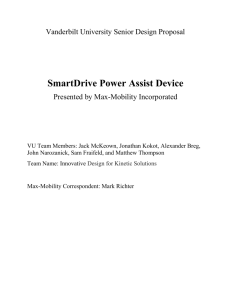
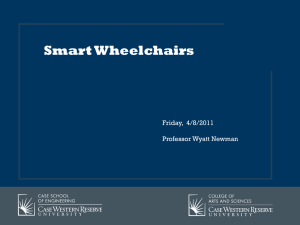
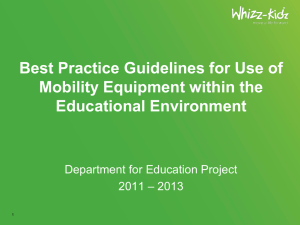
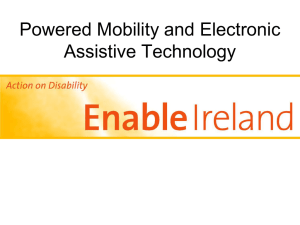
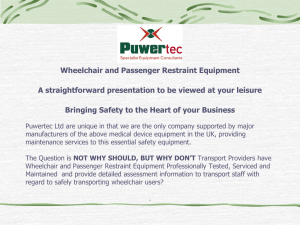
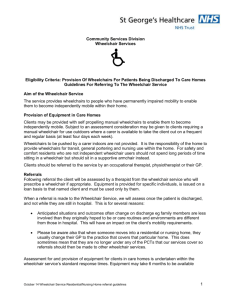
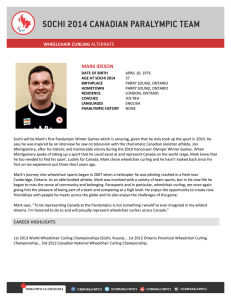

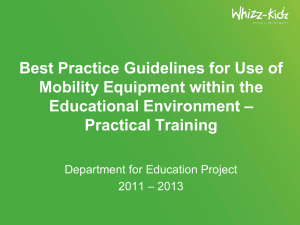
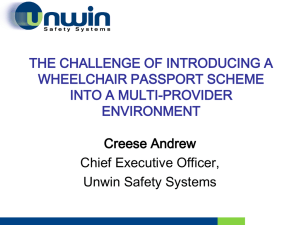
![Full paper [DOC 43 KB]](http://s3.studylib.net/store/data/005838945_1-04e1faa67f9c697009b4a282c6cbcb5e-300x300.png)
